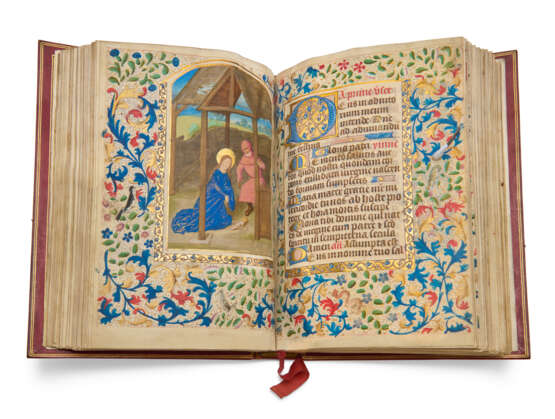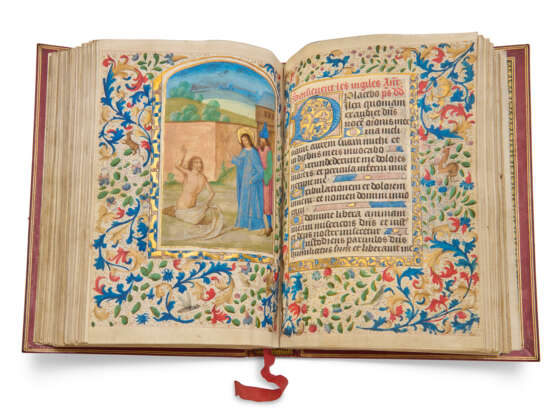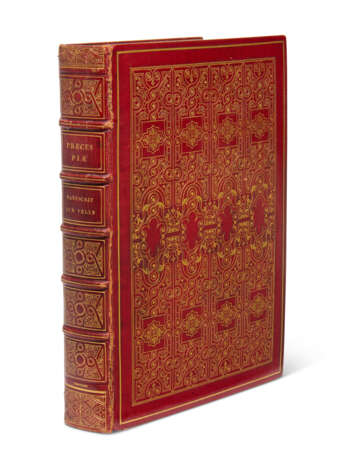ID 1449869
Lot 20 | Master of Dobrée 33
Estimate value
£ 70 000 – 90 000
Book of Hours, use of Rome, in Latin and French, illuminated manuscript on vellum [?Hainault, c.1480s]
The legacy of Simon Marmion, prince of illumination: a fine Book of Hours illuminated by the Master of Dobrée 33.
213 x 155mm. ii + 153 + ii leaves, too tightly bound to collate, 19 lines, written space: 120 x 83mm, a border of sprays of acanthus, flowers and fruit in the outer margin of every page, 26 small miniatures, seven full-page miniatures in full borders of similar design incorporating people, birds, beasts and grotesques and facing seven of ten rectos with five to six-line initials on gold grounds with similar full borders (lacking three miniatures on inserted leaves, opposite ff.25, 62, 91, leaves including three miniatures with terce, sext and end of none of the Office of the Virgin, at least one leaf with small miniature before f.150, smudging to f.18 including small miniature, slight flaking from miniatures ff.84, 89, 152).
Binding:
Binding by Joseph Thouvenin (1791-1834), signed on spine, red morocco gilt tooled à la fanfare, spine in six compartments gilt, second and third lettered 'PRECES PIAE' and 'MANUSCRIT SUR VÉLIN', doublures of green morocco densely gilt tooled and inlaid in a red morocco frame bordered with gilt fillets. Red morocco case with lock.
Thouvenin, a key figure in the history of 19th-century binding, ran his shop in Paris from 1811, rapidly acquiring an outstanding reputation for his skills as technician and designer and for his revival of earlier styles; the term à la fanfare originated with one of his bindings.
Provenance:
(1) The orthography of the calendar indicates an origin in the area of northern France and the south of the southern Netherlands; there are many feasts popular in Amiens, while the presence of St Bertin, his translation and St Omer (4 Sept.,16 July, 9 Sept.) are more indicative of the diocese of Thérouanne to the north-west; St Vaast of Arras, the diocese to the north-east, also appears (15 July). St Nicaise, patron of the archdiocese of Rheims is one of the few saints distinguished in red (14 Dec.). Although only Francis (4 Sept.) and Elizabeth of Hungary (19 Nov.) are named in the calendar, the litany suggests a connection with the Franciscans: St Francis heads a special section of monks and hermits, where Bernadino, canonised in 1450, appears; Louis of Toulouse is presumably the Louis named among both the bishops and the monks and hermits; Clare is among the virgins and widows, followed by Elizabeth, probably intended for Elizabeth of Hungary. She is included in the memorials, as is Francis and the more local saints Quentin, who gave his name to the town to the east of Amiens, and Adrian, whose relics were at Geraardsbergen in south-east Flanders. Prayers are in the masculine.
(2) Robert Hoe (1839-1909), presumably already owned by him when it appeared in Catalogue of an exhibition of illuminated and painted manuscripts together with a few early printed books with illuminations, New York, Grolier Club, 1892, no 39. Published in C. Shipman, A Catalogue of manuscripts forming a portion of the library of Robert Hoe, 1909, pp.24-25; his sale, New York, Anderson Galleries, Catalogue of the Library of Robert Hoe, part IV, 11-22 November 1912, lot 2340.
(3) Beverley Chew (1850-1924): his sale, New York, Anderson Galleries, The Library of the late Beverley Chew, Part 1, 8-9 December, 1924, lot 256.
(4) Christie’s, 28 April 1966, lot 160, with book labels of Hoe and Chew, since removed.
Content: added leaf with opening of St John’s Gospel f.1; calendar ff.2-13; Hours of the Cross ff.15-20v; Hours of the Holy Spirit ff.22-24; Office of the Virgin, use of Rome, with seasonal variations, lacking terce and sext after f.57, lacking end of none after f.61, ff.25-82; Stabat mater ff.82-83v; Obsecro te ff.84-87; O intemerata ff.87-89; prayers, opening with Avete omnes animae fideles ff.89-90v; Penitential Psalms ff. 91-99; litany and prayers, ff.99-106v; Office of the Dead, use of Rome, ff.107-144v; memorials to Sts George, Christopher, Quentin, Francis, Hubert, Martin, Adrian, Sebastian, Anne (lacking end), Katherine, Barbara, Margaret and Elizabeth of Hungary ff.145-152; seven verses of St Bernard ff.152-153; added opening of Gregory the Great’s homily for a martyr’s feast, Si consideremus fratres carissimi quae et quanta (Homiliae in Evangelia, CCSL, CXLIX, R. Étaix ed., 1999, no 37).
Illumination:
The miniatures have been attributed to the Master of Dobrée 33, named by Constantin Favre (see below) from a Book of Hours with a calendar for Hainault in the Musée Dobrée at Nantes (for Dobrée 33, see M. Gil, no 37, Trésors enluminés des musées de France. Pays de la Loire et Centre, P. Charron et al. eds, 2013). The Master is one of the distinct personalities to emerge from the ‘Betremieu’ group of illuminators, who worked for a clientele in the French speaking area of the western Southern Netherlands and adjacent areas of France (see B. Cardon, ’Saint Betremieu en andere heiligen. Over Henegouwse verluchte gebeden- en getijdenboeken uit de tweede helft van de 15de eeuw ‘, Leuvens Palet aangeboden aan de Heer P.V. Maes, 1989, pp. 41-62). Their name comes from the distinctive form of Bartholomew, found for the apostle’s feast on 24 August (here as ‘Bietremieu’). Their style, attractively muted palette, miniature patterns and overall book design depend closely on the work of Simon Marmion, the great ‘prince of illumination’ who had moved from Amiens to Valenciennes in Hainault by 1458. Marmion died in 1489 and this production, chiefly of Books of Hours, may have started within his workshop and under his direction.
The border around the Crucifixion, f.17v, with its acanthus in blue and brown heightened with gold, follows a type seen in Marmion’s Visions of Tondal, written in 1475 (J. Paul Getty Museum, ms 30), and Berlaymont Hours, where the compositions of the Visitation, Nativity, Presentation in the Temple and Raising of Lazarus follow the patterns that inspired the Master of Dobrée 33 (Huntington Library, HM 1173, ff.35, 53, 84). Like others in the Betremieu group, the Master pared down the scenes, reducing them to their essential protagonists, so that the Virgin enters the Temple alone, f.58v, and only one man witnesses Christ’s raising of Lazarus, f.117v. Whereas Marmion in the Salting Hours has Herod watching three soldiers confronting a mother and child (Victoria and Albert Museum, MSL/1910/2384, f.103v), here the Master has just one. In the Dobrée Hours, even the mother has been eliminated to focus entirely on the baby hanging limply in the single soldier’s grip. (For the Marmion mss, see T. Kren and S. McKendrick eds, Illuminating the Renaissance, 2003, nos 12, 14, 53; images available for all cited mss through collection websites.)
The very manner of painting serves the same end of focussing attention on the essential figures, which are painted with considerable care, particularly in the detailed modelling of faces. Landscapes and architectural settings, however, are free of distracting detail and executed in a more summary manner with looser, more spontaneous brushwork. The level of execution seems higher than in the Dobrée Hours, which has no small miniatures for the Hours of the Cross and less generous borders: the present lot is a more luxurious commission that encouraged the Master to work at his best.
The Master of Dobrée 33 did not work alone and shifting collaborations can be seen in the Betremieu Group. The hand of the small miniatures in the present lot, ff.73v, 82 and 84, was also responsible for small miniatures in a very closely related Hours by the Master from the Renate König Collection, now Cologne, Kolumba, Kunstmuseum des Erzbistums Köln, König-Hs 20 (see below), where the Coronation of the Virgin follows the identical composition, f.93, and the Master’s large miniatures mostly derive from the same patterns; there is a similar programme of small miniatures and similar borders, probably by the same illuminator. Both Dobrée 33 and the Kolumba Hours are among the group’s production intended for use in the diocese of Cambrai, specifically in Hainault, where they probably worked, perhaps centred on Marmion’s own location of Valenciennes or on Mons. The calendar of the present lot is not indicative of Hainault but of areas to the west, perhaps the French speaking southern part of the diocese of Thérouanne, adjacent to the dioceses of Amiens and Arras. An Hours from the group for the use of Thérouanne was sold in these rooms, 7 June 2006, lot 46.
For their help with this entry, we are grateful to Gregory Clark and Dominique Vanwijnsberghe, who generously communicated ahead of publication his article ‘Le Nord’, in Peindre en France: trente ans de recherches sur les manuscrits à peintures en France, Colloque de Genève, novembre 2023, F. Elsig ed. (forthcoming).
The subjects of the full-page miniatures are as follows: Crucifixion f.17v, Pentecost f.21v, Visitation f.43v, Nativity f.54v, Presentation in the Temple f.58v, Massacre of an Innocent f.68v, Raising of Lazarus f.107v.
The subjects of the small miniatures are as follows: Agony in the Garden f.15, Arrest of Christ f.16, Flagellation f.16v, Crowning with Thorns f.17v, Carrying the Cross f.18v, Crucifixion f.19, Entombment f.20, Coronation of the Virgin by the Trinity f.73v, Pietà f.82, Virgin and Child f.84, Virgin and Child and St John the Evangelist f.87, Death figure with raised dart and coffin lid f.89, St George f.145, St Christopher f.145v, St Quentin f.146, Stigmatisation of St Francis f.146v, St Hubert f.147, St Martin f.147v, St Adrian f.148, St Sebastian f.149, St Anne f.149v, St Katherine f.150, St Barbara f.150v, St Margaret f.151, Elizabeth f.151v; St Bernard f.152.
Literature
J.M. Plotzek, Andachtsbücher des Mittelalters aus Privatbesitz, Cologne, 1987, p.195.
J.H. Marrow, no 20 (König Hs 20) in J.M. Plotzek et al. eds, Ars vivendi Ars moriendi, 2001, p.330.
C. Favre, ‘Le Maître d’Antoine Clabault et la peinture à Amiens autour de 1500’, Peindre à Amiens et à Beauvais au XVe et XVIe siècles, F. Elsig, ed., 2021, pp. 83-93, p.86.
| Place of origin: | Western Europe, France, Europe |
|---|---|
| Auction house category: | Medieval & renaissance manuscripts, Books and manuscripts |
| Place of origin: | Western Europe, France, Europe |
|---|---|
| Auction house category: | Medieval & renaissance manuscripts, Books and manuscripts |
| Address of auction |
CHRISTIE'S 8 King Street, St. James's SW1Y 6QT London United Kingdom | |
|---|---|---|
| Preview |
| |
| Phone | +44 (0)20 7839 9060 | |
| Buyer Premium | see on Website | |
| Conditions of purchase | Conditions of purchase |








